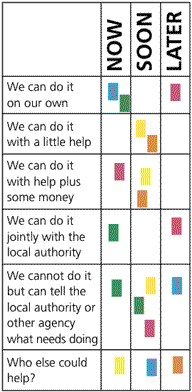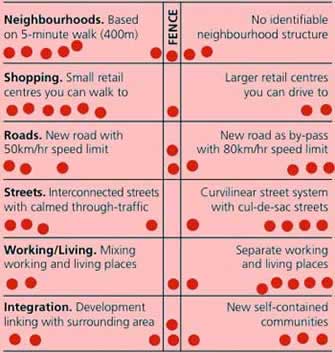Community Planning: Methods
Prioritising
- description
- more detail
Prioritising is a way of placing in order of priority what needs doing and when. This is an important aspect of all decision-making and often needs to be done as a group activity if the results are to be generally agreed on.
The various options are worked out using brainstorming, surveys or other methods.
A graphic format is selected to allow the prioritising of options to be simply and visually displayed. There are many ways of doing this, including the three examples shown here (and see also Choice catalogue, Ideas competition and Microplanning workshop).
After discussion of the issues, and perhaps presentations, participants make individual choices using stickers or cards.
The results are analysed and provide the basis for decision-making or further discussion.
The various options are worked out using brainstorming, surveys or other methods.
A graphic format is selected to allow the prioritising of options to be simply and visually displayed. There are many ways of doing this, including the three examples shown here (and see also Choice catalogue, Ideas competition and Microplanning workshop).
After discussion of the issues, and perhaps presentations, participants make individual choices using stickers or cards.
The results are analysed and provide the basis for decision-making or further discussion.

Prioritising projects
Matrix for placing cards identifying possible projects or actions needed.
Tips
- Often worth allowing people an opportunity to change their votes after seeing how others vote and discussing the results. This allows people to think through situations which are often quite complex.
- Facilitator's skill is finding the appropriate graphic format for the issues being considered.
- Great scope for using computers to process results, especially where large number of people and choices are involved.
Costs
- No significant costs involved apart from facilitator's fees if any.
Wheel of fortune group prioritising method
Way for a group of people to collectively rank up to 20 competing priorities.Suitable for a workshop or public meeting.
- Preparation
Large sheets of paper are taped together to create a big square on the floor or a table. The bigger the group, the larger it needs to be. A large circle is drawn on the paper, divided into as many slices as there are options. Each slice is labelled. - Coloured sticky notes
Participants are each given 3 cards or Post-it notes. Different colours can be given to people representing different interest groups. - Voting
Participants vote for their top three priorities by placing their cards or Post-its in the relevant slice. - Discussion and recording
Votes are counted and recorded for further discussion.
The process is repeated with different groups.
Ideal numbers: 10 15
Running time: 20 minutes

Fence prioritising method
Way for a group to arrive at a majority view on issues where there are conflicting options. Likely to be done after presentations, and discussion of the issues involved.
- A list of issues is prepared, perhaps by a consultant.
- The issues are illustrated graphically on lines with a 'fence' in the middle (see below).
- Participants discuss each issue in turn. After discussion, each participant places a dot somewhere along the line. A dot placed towards the end of a line indicates strong agreement for the given option. A dot in the middle indicates no strong views either way (ie 'sitting on the fence').
- The strongest concentration of dots (or the mean position of the sum of all the dots) is taken as the collective view.
Example below: planning a new settlement.

Thanks: Neighbourhood Initiatives Foundation, Wheel of Fortune: Robin Deane, 1066 Housing Association. Peter Richards, Deicke Richards Architects.